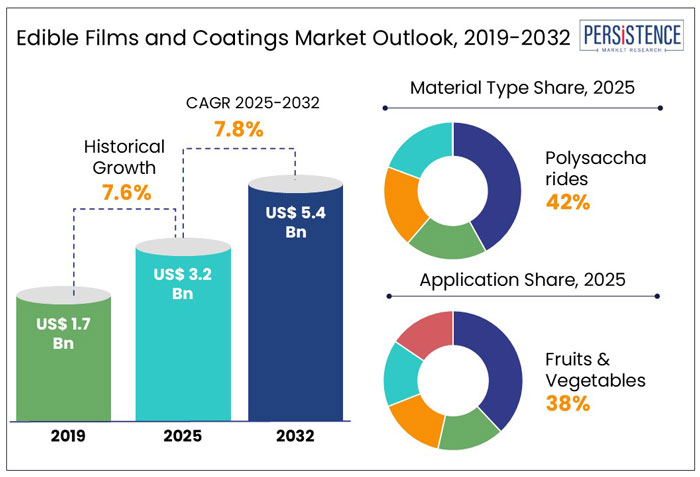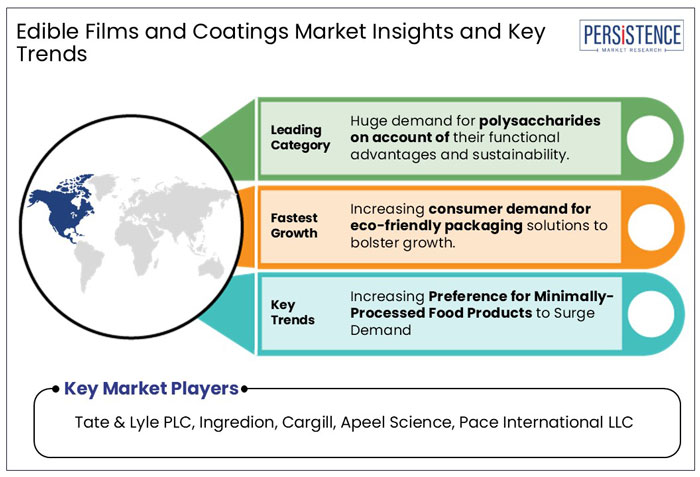Industry: Food and Beverages
Published Date: March-2025
Format: PPT*, PDF, EXCEL
Delivery Timelines: Contact Sales
Number of Pages: 188
Report ID: PMRREP29161
The global edible films and coatings market size is estimated to reach a size of US$ 3.2 Bn in 2025. The market is predicted to rise at a CAGR of 7.8% from 2025 to 2032 and is likely to attain a value of US$ 5.4 Bn by 2032.
Edible films and coatings help extend the shelf life of perishable foods by providing a barrier against moisture and oxygen, thereby reducing food wastage. According to the United Nations (UN), 1.3 billion tons of food are wasted every year, equivalent to about 30-50% of food produced. The growing awareness regarding food wastage and its environmental impact is leading consumers to prefer products with sustainable packaging solutions, which is projected to drive product demand in the forthcoming years.
According to Persistence Market Research, the market for edible films and coatings is poised for significant growth, driven by technological innovation, sustainability, and consumer preferences for eco-friendly and safe packaging solutions. Companies operating in the market are focusing on offering biodegradable alternatives to traditional packaging to minimize the rate of food spoilage. The increasing demand for plant-based food products is another factor that is propelling the food product manufacturers to invest in research and development activities to develop edible films using different components.

Key Highlights of the Market
|
Market Attributes |
Key Insights |
|
Edible Films and Coatings Market Size (2025E) |
US$ 3.2 Bn |
|
Projected Market Value (2032F) |
US$ 5.4 Bn |
|
Global Market Growth Rate (CAGR 2025 to 2032) |
7.8% |
|
Historical Market Growth Rate (CAGR 2019 to 2024) |
7.6% |
Market Showcased Resilience during COVID-19 Backed by Rising Consumer Trend Towards Sustainability
The global market for edible films and coatings registered a CAGR of 7.6% during the historical period between 2019 to 2024. The COVID-19 pandemic initially disrupted food industry supply chains and manufacturing processes globally, affecting the availability of raw materials and finished products. However, as economies reopened and supply normalized, the market witnessed accelerated growth. This was due to the increasing focus on food safety, sustainability, and reducing the use of synthetic additives. The adoption of natural ingredients like whey protein, gluten, and plant-based waxes became more prevalent, aligning with consumer preferences for clean-label products globally. Further, the market witnessed increasing research into new materials, such as silk proteins for edible coatings, which supported the market growth during the historical period.
In the forthcoming years, the growth of edible films and coatings is expected to be driven by sustainability initiatives, advancements in food preservation technologies, and increasing consumer demand for eco-friendly packaging solutions. The industry is likely to shift more towards plant-based materials, in line with the growing demand for clean-label and vegan products. Innovations in active packaging, such as antimicrobial and antioxidant-infused coatings, will be critical in increasing shelf life and minimizing food waste, driving the demand for the global edible films and coatings market during the forecast period.
Increasing Consumer Preference for Minimally-Processed Food Products to Bolster Product Demand
Processed food products like sugary cereals, prepackaged snacks, and instant noodles are linked to serious health risks. These foods account for a significant portion of daily calorie intake in several countries. However, as per studies, consuming large amounts of processed food products can lead to increased risks of cardiovascular disease and type 2 diabetes. Such products contain a high level of salt, sugar, and unhealthy fats.
Edible films and coatings offer a promising solution to mitigate the harmful effects of processed foods. By acting as natural barriers to moisture and oxygen transfer, they reduce the need for artificial preservatives commonly found in processed foods. Additionally, these coatings can be combined with functional ingredients such as antioxidants or antimicrobials that enhance nutritional value and safety.
For minimally processed foods like fruits and vegetables, edible coatings help maintain freshness and extend shelf life without compromising their natural state. This approach not only addresses consumer demand for healthier food options but also supports sustainability by reducing reliance on synthetic packaging materials. With rising awareness regarding the adverse health effects of consuming processed foods, the high demand for minimally processed food products globally is projected to be a significant growth driver in the market through 2032.
High Production Cost & Price Fluctuations of Raw Materials to Impede Market Growth
The fluctuation in the cost of raw materials such as proteins, polysaccharides, and lipids can drastically impact the production costs of edible films. This makes it less competitive compared to traditional packaging materials like plastics, especially in price-sensitive markets such as developing economies of Asia-Pacific, Latin America, and Africa.
Plastics are cheaper and widely available, and lower average income levels drive the demand for such a cost-effective solution despite their detrimental effects on the environment. Therefore, the higher cost of edible films and coatings is anticipated to limit their adoption in such regions. However, addressing these challenges requires an innovative approach by companies, like increasing accessibility through localized manufacturing and providing supportive government incentives for the development of sustainable packaging solutions.
Growing Demand for Plant-based Edible Coatings by Vegan Consumers to Create New Business Avenues
Increasing adoption of vegan diets has amplified the demand for plant-derived products, including edible coatings made from proteins and lipids sourced from vegetables, fruits, and grains. Veganuary, the global organization encouraging people to savor vegan food in January and beyond, reported participation of 25.8 million people in January 2025. A new sister campaign, V-March, is expected to bring the Veganuary concept to people in China. Further, the organization plans to expand its global presence with new campaigns scheduled in Peru, Canada, and Malaysia. Such initiatives are expected to lead to more people adopting a vegan diet, which in turn is anticipated to support the growth of the market for edible films and coatings during the forecast period.
Polysaccharide-based Edible Films Gain Popularity Backed by High Demand for Sustainable Packaging
Based on material type, the polysaccharides segment is projected to hold a market share of about 42% in 2025. Polysaccharides are highly beneficial for edible films and coatings due to their sustainability, versatility, and ability to incorporate active compounds for enhanced food preservation. Pairing them with other biopolymers can overcome limitations like moisture sensitivity, while advancing their applications in sustainable food packaging systems. Owing to their non-toxicity and biodegradability, they are being preferred over traditional plastic packaging, which is likely to surge their demand through 2032.
The protein segment, on the other hand, is anticipated to witness substantial growth in 2025, driven by increasing adoption in manufacturing processes globally. Plant-based proteins like soybean, wheat gluten, and others, along with animal proteins like gelatin, are used in the manufacturing of edible films and coatings.
Fruits and Vegetables Segment to Hold 38% Share Fueled by Increasing Demand for Food Safety
Based on application, the fruits and vegetables segment is expected to register the highest revenue share of about 38% in 2025. Edible coatings play an important role in preserving the quality, reducing microbial spoilage, extending shelf life, and enhancing the sustainability of fruits and vegetables. Their ability to incorporate bioactive compounds further boosts their effectiveness in maintaining food safety and nutritional value during storage.
The meat, poultry, and seafood segment is projected to be the second-largest in terms of market share. The growing preference to buy products with edible films and coatings over synthetic plastic packaging is driving the demand for the segment.

Integration of Smart Packaging Solutions to Spur Product Demand in North America
North America is likely to dominate the global market for edible films and coatings in 2025 with a share of about 27.1%. It is further expected to witness substantial growth in the forthcoming years. The U.S. is anticipated to be a major contributor to propel the demand for the product. Presence of established players, easy availability of the product, and adoption of smart packaging technologies are projected to drive the growth of the market. For example, in January 2022, Akorn Technology, a company based in the U.S., launched smart, multifunctional edible coatings designed for fresh produce. These coatings help to extend the shelf life of fruits and vegetables and reduce cold chain losses by over 30%.
Companies Focus on Expansion Through Significant Investments in Research & Development
Asia-Pacific is forecasted to be the second-largest contributor in the market for edible films and coatings during the forecast period. China, Japan, and India are the major countries in the market. In China, xanthan gum is the most common edible coating used in food products, which is expected to drive the demand for polysaccharide-based films and coatings.
Major players like Nagase & Co. Ltd and Tate & Lyle are focusing on investing in research and development activities to develop biodegradable edible coatings that will help to prolong the freshness and extend the shelf life of food products. Moreover, the rising awareness regarding the environmental impact of traditional plastic packaging, food safety, and the benefits of biodegradable packaging is likely to drive significant growth in the region during the forecast period.
Companies Focus on Development of Eco-Friendly Products to Gain Stronghold in Europe
The market for edible films and coatings in Europe is anticipated to witness substantial growth during the forecast period. Germany is projected to remain dominant, followed by the U.K. and France. Factors such as increasing consumer awareness regarding health and nutrition, growing preference for sustainable packaging solutions, and ongoing research and development efforts are driving the demand for the market in this region.
Companies are increasingly developing plant-based edible coatings made from natural, biodegradable materials like polysaccharides, proteins, and lipids. For example, Apeel Sciences introduced its plant-based coating, Edipeel, in the U.K. markets such as Tesco and ASDA. This coating reduces water loss and oxidation in fresh produce like oranges and lemons, leading to reduced food wastage.
The market for edible films and coatings is very dynamic, with both domestic and international manufacturers present. The major players operating in the market include Cargill, Tate & Lyle, Ingredion, Akorn Technologies, and others. Businesses are focusing on sustainability, product variety, and innovation to keep their competitive advantage.
Growing consumer demand for packaged goods and fresh produce has given local businesses the chance to broaden their product lines, while strategically focusing on affordable and plant-based options. Collaborations with food producers, investments in biodegradable materials, and product innovation by companies are anticipated to favor market growth in the forthcoming years.
|
Attributes |
Details |
|
Forecast Period |
2025 to 2032 |
|
Historical Data Available for |
2019 to 2024 |
|
Market Analysis |
US$ Billion for Value Tons for Volume |
|
Key Regions Covered |
|
|
Key Market Segments Covered |
|
|
Key Companies Profiled in the Report |
|
|
Report Coverage |
|
|
Customization and Pricing |
Available upon request |
By Material Type
By Application
By Function Type
By Region
To know more about delivery timeline for this report Contact Sales

The market is set to reach US$ 3.2 Bn in 2025.
The industry will likely be valued at US$ 5.4 Bn in 2032.
Tate & Lyle PLC, Ingredion, Cargill Incorporated, and Apeel Sciences are a few leading players.
The industry is estimated to rise at a CAGR of 7.8% through 2032.
North America is projected to hold the largest share of the industry in 2025.